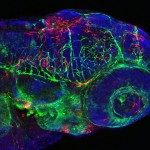Link to Pubmed [PMID] – 19409194
Med Sci (Paris) 2009 Apr;25(4):405-11
Teleosts, the modern branch of bony fishes, make up the richest group among Vertebrates with more than 20.000 species displaying considerable diversity and found in all aquatic biota. The basal position of fish in vertebrate phylogeny makes them very attractive for genomic and functional comparative studies, especially of the immune system. Although the rapid evolution of proteins involved in immunity and the tumultuous history of fish genomes often obscure the identification of orthologous genes, these studies have demonstrated that the essential components of the mammalian immune system (macrophages, B and T lymphocytes whose receptors undergo V(D)J recombination, MHC, CDs, cytokines, interferon pathway…) are present in fish. The discovery of fundamental immune mechanisms in fish uncovers the primordial vertebrate immune repertoire ; while some unique adaptations also illustrate how a group undergoing adaptative radiation may innovate, drawing on the available genomic resources, in response to specific constraints.

